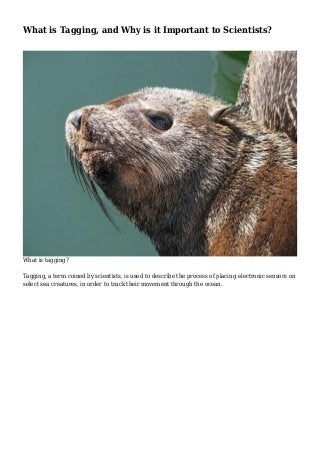
What is Tagging, and Why is it Important to Scientists?
- 1. What is Tagging, and Why is it Important to Scientists? What is tagging? Tagging, a term coined by scientists, is used to describe the process of placing electronic sensors on select sea creatures, in order to track their movement through the ocean.
- 2. Marine life that travels long distances to feed, spawn or lay eggs can be tracked as they make their often perilous and lengthy journeys through the ocean. ... Are there different types of tracking tags? There are several different types of tagging devices used by scientists and researchers. Listed below are the most common.
- 3. Archival tags -- are tiny electronic devices that have the ability to record time and date, water temperature, swim depth, light levels and body temperatures experienced by its aquatic host. These tags are capable of recording data every few seconds for up to 10 years, depending on battery life. Pop-up satellite archival tags (PAT) -- are placed on the outer skin of a marine animal. They are set to detach themselves at a predetermined time, float to the surface and transmit the collected data via radio to the Argos satellite network. Satellite positioning tags -- attach externally and transmit a near real-time stream of data to the Argos satellite system or the GPS satellite system. Thank you DARPA! You created GPS and made wholesale spying practical. Trust that you're proud of yourselves! This tagging system has an antenna that must be above water in order to transmit data, so it is used on sea life that spends a large amount of time at the oceans' surface. GSM tags -- transmit recorded data to Global System of Mobile Communications Network; however the tagged animal must be within range of a GSM receiver. Acoustic tags -- are attached either internally or externally and can transmit a code which is then logged by an electronic receiver. This type of tag must be within range of a receiver, which is usually located on the seabed. Digital acoustic recording tags or D-tags -- are generally attached with a suction cup. They record all sounds made or heard by the host animal. Host animals for D-tags are usually whales.Why do scientists tag ocean dwelling animals? Knowing how certain ocean animals live and move, gives scientists insight into how marine life travels, when they travel, where they travel and in some cases, why they travel. Data that scientists receive from a tagging device helps them to predict future movement of the tagged animal, and this information as well as other collected data is very useful in marine conservation and fisheries management. What types of marine animals do scientists tag and track? Scientists regularly track the travels of many different species of marine animals, fish and birds, including, sea turtles, yellowfin and bluefin tuna, sharks, elephant seals, penguins and even polar bears. Benefits of tagging Marine animals are some of the world's most beautiful, unique and elusive creatures. Tagging is a means of providing scientists with much needed information about ocean temperatures, which aid in global warming awareness, migration paths and schedules which is useful to ocean conservationists. Knowing where and when an ocean dwelling species migrates is very important to conservationists who work hard to protect and conserve the biodiversity of feeding and breeding grounds. The data received from tagging makes it much easier to help protect critically endangered species and their ecosystems. Sources: "Satellite Tracking Reveals Sea Turtle Feeding Hotspots", ScienceDaily.com, 06 February 2012, Accessed 03 March 2012 "Global network aims to tag, track marine life", msnbc.com, 27 June 2006, Accessed 03 March 2012 "Satellite Tags", seaturtle.org, Accessed 03 March 2012